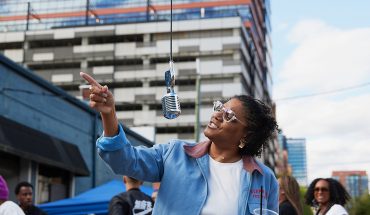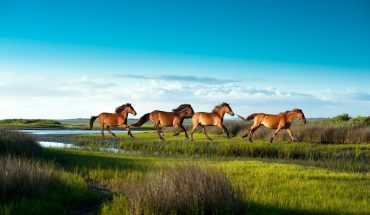by CC Parker
photograph by Robert Willett
I admit it: I chuckle at Segway tours. Lined up like ducks. Helmeted. All leaning forward, slightly bow-legged, intent on their mission… and what is that mission?
And yet, there I was, on a Segway, zooming behind my father on a tour of Oakwood cemetery. Helmet, earphone, and all.
Intending another in-town outing with one of my children, I had bought Segway tickets through the coupon website LivingSocial. Unfortunately, I had neglected to read the small print. My nonrefundable tickets had to be used by someone 18 or older. At the time, my three children ranged from 4 to 10.
Plan B: Dad’s birthday. I did not tell him our destination. I asked him to pick me up at high noon on the designated day.
Tottering on a Segway was probably daunting, given his double knee replacement, but Dad was a great sport. The staff at Triangle Glides was thorough: We were suited up with helmets (with headphones), given a lesson on how to use them, and asked to demonstrate our ability. And we were given clear directives:
1. Listen to the guides’ instructions
2. Stay in a single-file line
3. No racing.
4. Do NOT Reverse.
I’d been preschool room mom for all three of my children. This outing was starting to feel oddly familiar.
Starting at the City Market downtown, we hummed along, single file, navigating bumps in the sidewalk, as we made our way to Oakwood. At each intersection, one instructor would stop traffic, one guide led us across, and one guide brought up the rear… just like in preschool.
Naturally, we did what preschoolers do. Once we got our bearings, we started to double up and race. I was the youngest by at least 15 years and those “old guys” (it’s always the guys) were racing to be first – my father included. We weren’t even quite sure where we were going, but each of us wanted to get there first and be “the door holder.”
This was not the instructors’ “first rodeo,” unsurprisingly. We were quickly rounded up and queued back in line. As we entered the Oakwood neighborhood, the official tour began.
What did I know about Oakwood Cemetery? We Raleigh natives grew up hearing the story of the Mordecai family’s well-timed donation of two and half acres of farm land to establish a Confederate cemetery, which later became Oakwood Cemetery.
I also knew how that had come about. I knew that when the Civil War ended, Rock Quarry Cemetery, on Rock Quarry Road in Southeast Raleigh, had to figure out what to do with the many Confederate soldiers buried within its walls. The war’s end had turned the site into Raleigh National Cemetery, and Confederate soldiers were no longer permitted in federal plots. In most cases, if a Confederate soldier remained in a federal cemetery, a prominent “Rebel” sign was placed on his grave.
As Robin Simonton, the director of Oakwood Cemetery, says: “To the victors go the spoils and the cemeteries.”
As the story goes, in 1867, Raleigh residents were told that they had to remove their dead Confederate soldiers immediately from what was now the federal cemetery, or the remains would be left on the street.
The women of Raleigh had anticipated this happening and had already raised money and scoured the area for an alternate Confederate resting place. When they settled on the Mordecai property, Mr. Mordecai refused payment, directing the women to use their money to turn his farm into a suitable resting place.
When the time came to relocate the buried Confederate soldiers, the Raleigh community rallied under the leadership of H.J. Brown (founder of Brown-Wynne funeral home). Some had to move their own buried husbands, sons, or neighbors, and transport them. In total, 494 bodies were moved to Oakwood in a matter of weeks, each escorted by the women to his new final resting place.
There are 1,400 Confederate soldiers now buried at Oakwood. Of these, 137 were brought from Gettysburg, and 107 came from Arlington when the National Cemetery Act of 1881 required their removal from that property.
Oakwood has since expanded to 102 gorgeous garden-style acres and now has 22,000 permanent residents.
This may sound creepy, but I feel right at home at Oakwood.
When I was growing up, it was completely normal to be gathered at the dinner table and have my mother say, “I stopped by to visit grandmother today.” Meaning, “I stopped by Oakwood Cemetery to say hello to your great-grandmother who died 30 years ago.” Sometimes she’d drop flowers from her garden, other times she’d just drop by for a quick visit. At dinner those evenings, she would report her visit, as well as the friends she saw visiting their own deceased “family.”
Perhaps her affection for Oakwood explains my father’s regrettable birthday gift to Mom one year of two Oakwood plots. It was a dark day in our house.
These days, Mom has even more “family” to visit. My grandparents have now joined my great-grandparents, though my grandfather doesn’t know it, as he was originally buried in Kinston (long story). Mother didn’t want him alone, so she had him exhumed and brought to Raleigh. Poor guy will spend eternity at his mother-in-law’s feet.
We tease our parents about this craziness, and yet there I was in Oakwood, helmeted, and on a Segway, soaking it all in.
The guides led us throughout the cemetery, stopping at various spots along the way. I remember as a child hearing my mother say that a Cherokee woman was buried there who had been shunned for her marriage to a white man (A. G. Bauer, the well-known architect of the Governor’s Mansion). She died of a broken heart. Upon her death, he built for her a miniature Temple of Diana with a photo of her inside it. He killed himself the next year.
We also visited Berrien “Red” Upshaw, Margaret Mitchell’s first husband, a real life Rhett Butler, killed in a bar room brawl. We saw Elizabeth Edwards’ very simple headstone, which rests close to the massive sculpture at her son Wade’s grave. Lizzie Bunker, who was a daughter of one of P.T. Barnam’s famous Siamese twins, is there. (Side note: Those twins toured the world, and when retired, remained co-joined and settled in Mount. Airy, married sisters, and collectively had 21 children. Stop and think about that for a minute…)
And if you’re looking for ghosts, there is the legend of the Ratcliffe Angel. The legend says that if you go at midnight and shine your flashlight on her face, she will stare right back at you. If she likes you, she’ll flutter her wings…. Boo! I took my daughter and some of her friends – in full Halloween costumes – at dusk to view the Ratcliffe Angel.
Last stop, the grave of Karl Hudson Sr., founder and managing partner of Hudson-Belk department stores. Our guide told the group that Mr. Hudson searched the Raleigh area on horseback looking for the ideal location for Raleigh’s first store. His grandson, our next-door neighbor, confirmed this. This was a relief, as I had sort of wondered if our guides made up trivia as they rode along.
Many of the names on the headstones may not be celebrities but are still familiar. Some are the same (perhaps the very same?) that you see scrawled on the brown packages of pressed items awaiting pick-up at nearby Rollins Cleaners on Peace Street.
As our group toured the grounds, Dad and I agreed: We felt as if we were at a family reunion. Lots of people milled throughout the garden. Children laughed as they chased through the headstones. The maintenance staff buzzed throughout.
As we were leaving, Dad pulled alongside me, nodding in a particular direction of the cemetery. “Your mother and I are over there,” he said as casually as if he were pointing out their new condo. And then our group hummed away.




